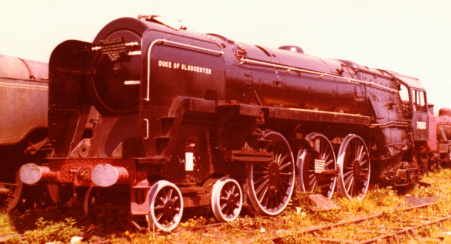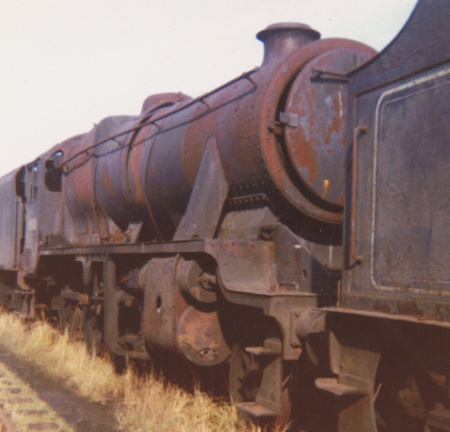
|
|
|
The Barry Scrapyard story, part 2
The first locomotive to be the subject of a rescue appeal from Barry was the GWR 'Mogul' number 5322, but the first to be bought and actually moved from the yard was LMS '4F' 0-6-0 number 43924 in September 1968. January 1970 saw the next engine to be moved, SR 'U' class number 31618, but it was not until the mid-1970s when the mass exodus began. Nobody at this stage thought that many of the Barry locomotives would be saved and certainly not the 213 engines that were eventually moved to pastures new. The Barry Scrapyard Story Locomotives Saved from Barry Scrapyard The order of leaving Barry Scrapyard Home Page Locomotive name database Preserved Steam Locomotives Sounds of Steam Back to Basics The Modernisation Plan Sitemap Steam Locomotive Index Copyright © by John Daniel 2013.
The price of each locomotive was set at its equivalent scrap value; not a pound more and not a pound less and there was no haggling! Woodhams kept a complete breakdown of the amount and different types of metal that each locomotive contained. By applying the 'going rate' for steel or copper scrap to the known weights, a realistic price was calculated. But there were several liabilities that affected both Woodhams and the prospective purchasers. One of the many contract conditions entered into by the private scrapyards  and BR was that locomotives sold for scrap could not be resold. This was primary to stop less scrupulous dealers buying an engine at scrap value and then selling it on at a highly inflated price to a private railway or preservation society. BR charged a levy - that had to be added to the purchase price - for complete locomotives sold by Woodhams, although this charge was eventually abandoned. Another burden, this time paid by Dai, was the rental charge for the yard at Barry paid to Associated British Ports for each locomotive, for each year. Although some locomotives were fully paid for but remained at the yard while preservationists worked on the engines, it all had to come from Dai's own pocket. But one charge that would alter prices substantially was the introduction of Value Added Tax in 1973, initially set at 10% but raised to 15% in 1979.
and BR was that locomotives sold for scrap could not be resold. This was primary to stop less scrupulous dealers buying an engine at scrap value and then selling it on at a highly inflated price to a private railway or preservation society. BR charged a levy - that had to be added to the purchase price - for complete locomotives sold by Woodhams, although this charge was eventually abandoned. Another burden, this time paid by Dai, was the rental charge for the yard at Barry paid to Associated British Ports for each locomotive, for each year. Although some locomotives were fully paid for but remained at the yard while preservationists worked on the engines, it all had to come from Dai's own pocket. But one charge that would alter prices substantially was the introduction of Value Added Tax in 1973, initially set at 10% but raised to 15% in 1979.
For Dai Woodham, the boom that arrived at Barry scrapyard came as quite a shock for until that time, he had only to contend with his few men working on wagon cutting and submitting tenders to British Railways. In addition the docks were relatively quiet, but now he had to handle the 'railway enthusiast'. "I found it a totally new experience," said Dai. "In the main 'they' were alright but I found more and more of my time was spent talking to people on the phone who wanted to buy a Bullied Pacific or something and could they pay me by instalments." Like a true gentleman, not only did he allow weekend working parties to work on their prospective purchases but also payment by instalment for the locomotives that continued even after they had left the yard.
As with most scrapyards up and down the country, there was a small amount of petty pilfering and to combat this Woodhams removed the tender axlebox brasses, copper pipes and whistles and these parts were handed to the new locomotive owners. Any other parts that were missing from reserved locomotives, Dai allowed the owners to take a similar part from an unreserved engine on the strict understanding that no substantial damage was incurred in removing the parts. At this stage it was preferable to see valuable spares saved rather than destroyed while there was still the threat of imminent cutting of the remaining engines.
copper pipes and whistles and these parts were handed to the new locomotive owners. Any other parts that were missing from reserved locomotives, Dai allowed the owners to take a similar part from an unreserved engine on the strict understanding that no substantial damage was incurred in removing the parts. At this stage it was preferable to see valuable spares saved rather than destroyed while there was still the threat of imminent cutting of the remaining engines.
By the late 1970s however, there was a new style of theft and on a much more serious scale - vital parts were now disappearing from the yard almost every weekend with a total disregard as to whether the engines were reserved or even bought and paid for by their new owners. Additionally, the damaged that was caused when those parts were stolen was nothing short of criminal. Perhaps the worst case relates to a Bullied Pacific which had its boiler washout plugs removed; as this could not be done in the normal way, those responsible actually cut-out the surrounding area of the firebox with an oxy-acetylene torch. Occasionally people were caught and prosecuted, but the position got so bad that in 1981 a total ban was placed on weekend working parties in the yard.
As the 1970's progressed the number of rescue attempts became fewer and with the uncertainty of continued wagon supplies, the 100 or so locomotives in the yard that remained unpurchased looked to be in a vunerable position. By this time examples of all the classes that had survived in the yard were to be found elsewhere, but numerous people felt that not only would it be desirable to save as many of the locomotives that remained at Barry, but that they would also be needed on the existing and the proposed private lines around the country.
Following much correspondence in the railway press, a group of like-minded people met on the 10th of February 1979 to review the options available. The outcome was the formation of the 'Barry Steam Locomotive Action Group' with the simple objective of securing the future of as many of the locomotives at Barry scrapyard - a statement that was easy to make, but much more difficult to put into effect. Headed by Francis Blake, they began by increasing awareness of the locomotives and their types in the yard, to liaise with prospective purchasers and with the scrapyard, and to put people in touch with one another, particularly those who wanted to contribute to - or purchase jointly - any of the remaining locomotives. However one setback for group was in the summer of 1980 when the supply of the all important wagons dried up. Consequently to keep the men at Woodham's in employment, Class 9F 92085 and 5101 class number 4156 were cut up. Fortune then smiled as the holiday period arrived and when the men returned, more wagons had been delivered to Barry.
Part One: A family business Part Three: A man never forgotten
British Railways Great Western L.M.S. L.N.E.R. Southern
1st to 70th 71st to 140th 141st to 213th Locomotives scrapped at Barry
